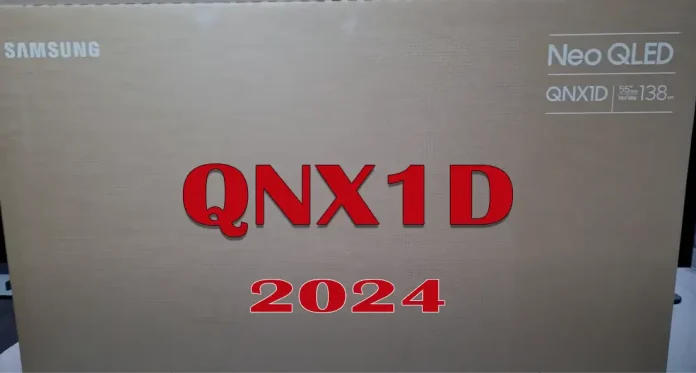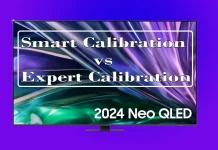For over seven years, Samsung has occasionally released TV models that break away from its usual model numbering conventions, standing out from the rest of its lineup. However, in 2024, Samsung set a new record by introducing a unique model in the Crystal UHD series and across its QLED and Neo QLED lines. This has sparked curiosity among many, as people wonder how this model distinguishes itself from the other offerings in these categories.
Differences of Samsung Neo QLED 4K QNX1D from other models
In fact, there are no significant super-large differences from other models, for example, I compared several similar models:
Samsung Neo QLED 4K QNX1D
Samsung Neo QLED 4K QN85D
Samsung Neo QLED 4K QN90D
Samsung Neo QLED 4K QN85C
Below is a table comparing the specifications of these models.
| Specs | Samsung Neo QLED 4K QNX1D | Samsung Neo QLED 4K QN85D | Samsung Neo QLED 4K QN90D | Samsung QLED 4K QN85C |
|---|---|---|---|---|
| Year | 2024 | 2024 | 2024 | 2023 |
| Type | NeoQLED | NeoQLED | NeoQLED | NeoQLED |
| Series | 8 | 8 | 9 | 8 |
| Size | 55″, 65″, 75″, 85″ | 55″, 65″, 75″, 85″ | 43″, 50″, 55″, 65″, 75″, 85″, 98″ | 55″, 65″, 75″, 85″ |
| Design | Simple Chamfer, Flat Feet Stand, 3 Bezel-less, Flat look | Simple Chamfer, One Touch Hexagon Stand, 3 Bezel-less, Flat look | Neo Slim, Sharp Neck Hexagon Stand, 4 Bezel-less, Flat look | Neo Slim, Hexagon Plate Stand, 4 Bezel-less, Flat look |
| Stand Color | Black | Titan Black | Titan Black | Sand Black |
| Front Color | Graphite Black | Graphite Black | Graphite Black | Titan Black |
| Inch | 65 | 65 | 65 | 65 |
| Diagonal Screen Size (Inch) | 64.5 | 64.5 | 64.5 | 64.5 |
| Resolution | 4K (3,840 x 2,160) | 4K (3,840 x 2,160) | 4K (3,840 x 2,160) | 4K (3,840 x 2,160) |
| Refresh Rate | 120Hz | 120Hz | 120Hz (Up to 144Hz) | 120Hz |
| Anti Reflection | Yes | – | Yes | – |
| Color | 100% Color Volume | 100% Color Volume | 100% Color Volume | 100% Color Volume with Quantum Dot |
| HDR (High Dynamic Range) | Neo Quantum HDR | Neo Quantum HDR | Neo Quantum HDR+ | Neo Quantum HDR |
| Viewing Angle | Wide Viewing Angle | Wide Viewing Angle | Ultra Viewing Angle | Wide Viewing Angle |
| Picture Engine | NQ4 AI Gen2 Processor | NQ4 AI Gen2 Processor | NQ4 AI Gen2 Processor | Neural Quantum Processor 4K |
| Motion Technology | Motion Xcelerator 120Hz | Motion Xcelerator 120Hz | Motion Xcelerator 144Hz | Motion Xcelerator Turbo+ |
| Auto HDR Remastering | Yes | Yes | Yes | Yes |
| Smart Calibration | Basic | Basic | Basic/Professional | Basic |
| AI Upscale | 4K AI Upscaling | 4K AI Upscaling | 4K AI Upscaling | Yes |
| Filmmaker Mode | Yes | Yes | Yes | Yes |
| Micro Dimming | Ultimate UHD Dimming | Supreme UHD Dimming | Ultimate UHD Dimming | Supreme UHD Dimming |
| Sound Output (RMS) | 40W | 40W | 60W | 60W |
| Speaker Type | 2.2CH | 2.2CH | 4.2.2CH | 2.2.2CH |
| Q-Symphony | Yes | Yes | Yes | Yes |
| Dolby Atmos | Yes | Yes | Yes | Yes |
| Object Tracking Sound | OTS Lite | OTS Lite | OTS+ | OTS |
| Adaptive Sound | Adaptive Sound Pro | Adaptive Sound Pro | Adaptive Sound Pro | Adaptive Sound+ |
| Bluetooth Audio | Yes | Yes | Yes | Yes |
| Eco Sensor | Yes | Yes | Yes | Yes |
| HDMI | 4 | 4 | 4 (4K 144Hz for HDMI 1/2/3/4) | 4 (4K 120Hz for HDMI 1/2/3/4) |
| USB | 2 x USB-A | 2 x USB-A | 2 x USB-A | 2 x USB-A |
| Ethernet (LAN) | 1 | 1 | 1 | 1 |
| Digital Audio Out (Optical) | 1 | 1 | 1 | 1 |
| RF In (Terrestrial/Cable input) | 1/1 (Common Use for Terrestrial) | 1/1 (Common Use for Terrestrial) | 1/1 (Common Use for Terrestrial) | 1/1 (Common Use for Terrestrial) |
| WiFi | Yes (Wi-Fi 5) | Yes (Wi-Fi 5) | Yes (Wi-Fi 5) | Yes (Wi-Fi 5) |
| Bluetooth | Yes (BT5.2) | Yes (BT5.2) | Yes (BT5.2) | Yes (BT5.2) |
| Package Weight (lb) | 69.4 lb | 76.5 lb | 78 lb | 77.6 lb |
| Set Weight without Stand (lb) | 50.9 lb | 50.9 lb | 53.4 lb | 52.2 lb |
| Set Weight with Stand (lb) | 52 lb | 59.1 lb | 60.6 lb | 60.2 lb |
| Stand Weight (lb) | 1.1 lb | 8.2 lb | 7.3 lb | 7.9 lb |
| Operating System | Tizen 8.0 | Tizen 8.0 | Tizen 8.0 | Tizen 7.0 |
| Built-in Voice Assistant | Alexa | Alexa | Alexa | Alexa |
| Web Browser | Yes | Yes | Yes | Yes |
| SmartThings Hub | Yes | Yes | Yes | Yes |
| Gaming Hub | Yes | Yes | Yes | Yes |
| VESA Standard | 400 x 300 | 400 x 300 | 400 x 300 | 400 x 300 |
The QNX1D and QN85D are very similar, but have a few key differences. The QNX1D has an anti-reflective screen coating, which sets it apart from the QN85D. Additionally, the QNX1D utilizes Ultimate UHD Dimming, while the QN85D features Supreme UHD Dimming. These differences suggest that the two models likely use different displays, although they are otherwise quite comparable TVs.
Possible reasons for releasing the QNX1D model
As previously stated, Samsung occasionally releases models with unique numbering that differs from the usual, and one possible reason for this could be the use of leftover components. For example, Samsung stopped producing its own LED panels for TVs in 2021 after selling its factory to TCL, losing direct control over the production of large LED displays and switching to outside suppliers.
Imagine that in 2023, Samsung signed a contract to receive 1,000,000 Neo QLED displays, but due to a shrinking market, the total number of TVs still needed to be produced. By then, new models with different components were already planned for the following year; it’s possible that the new models technically can’t use the old components. In this case, Samsung may create a transitional model such as the QNX1D to use unused components from earlier series, ensuring that the remaining components are used but adapting the TV to the new OS.
Is it worth buying Samsung QNX1D?
My opinion, it is quite normal TV with a new version of the OS, but since this is a transitional model of TV, the offers of such TVs will not be much, most likely this model of TV will be produced until the exhaustion of components. Such TV models may be offered at a discount for faster sales.





